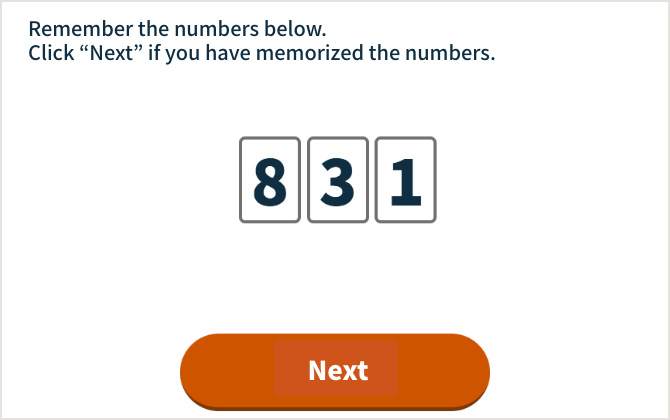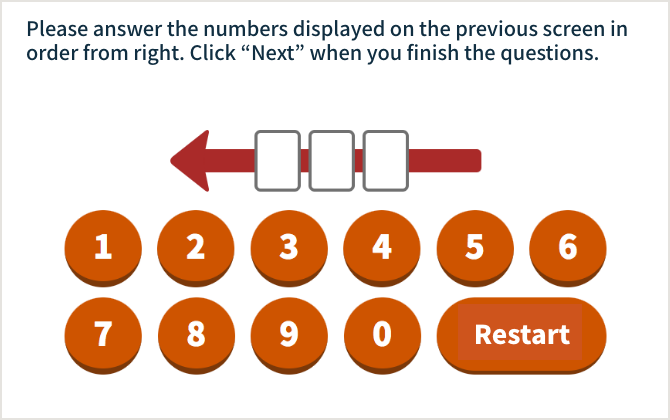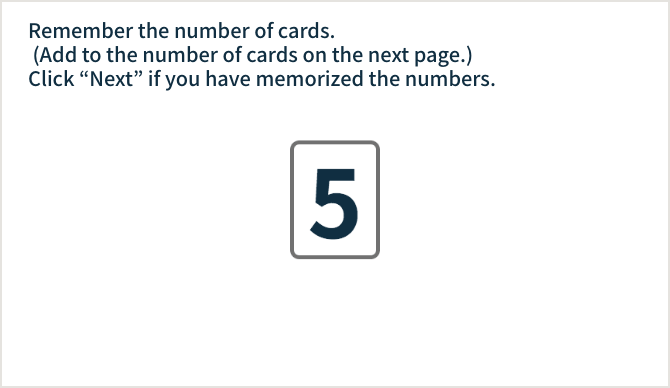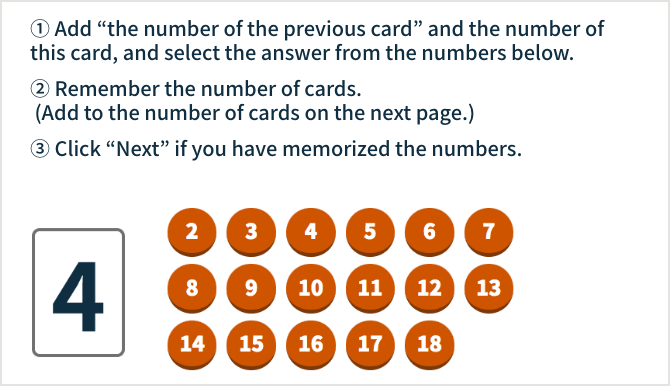
Introduction ~ Mechanism of dementia ~
The pre-symptomatic stage of dementia
cannot be detected by the current
medical tests.
01What is dementia exactly?
The state such as "I struggle with the words when having conversations" and "I can't remember what I was trying to do" which happen daily merely indicate the aging of the brain.
If you have dementia, your ability to recognize, remember and judge will be impaired, which will lead to the condition such as "I don't remember having the meal" or "I don't know where I am."
Dementia is a disease that cannot be cured completely once a person begins to have symptoms. No effective treatment has been found yet. It is extremely important to take measures while the brain is in a healthy state.
02Can’t be assured that one does not have dementia even have the brain
checked out with MRI
For example, even if you have the brain checked out with MRI, no symptoms of dementia can be discovered.
When the shrinkage of brain is detected by brain MRI, dementia has already progressed to the stage that one can no longer walk to the hospital.
It should not be considered as "I have the brain MRI already, so I need not worry about dementia". The decline of cognitive function progresses and quite a few people get dementia.
03 Mechanism of dementia
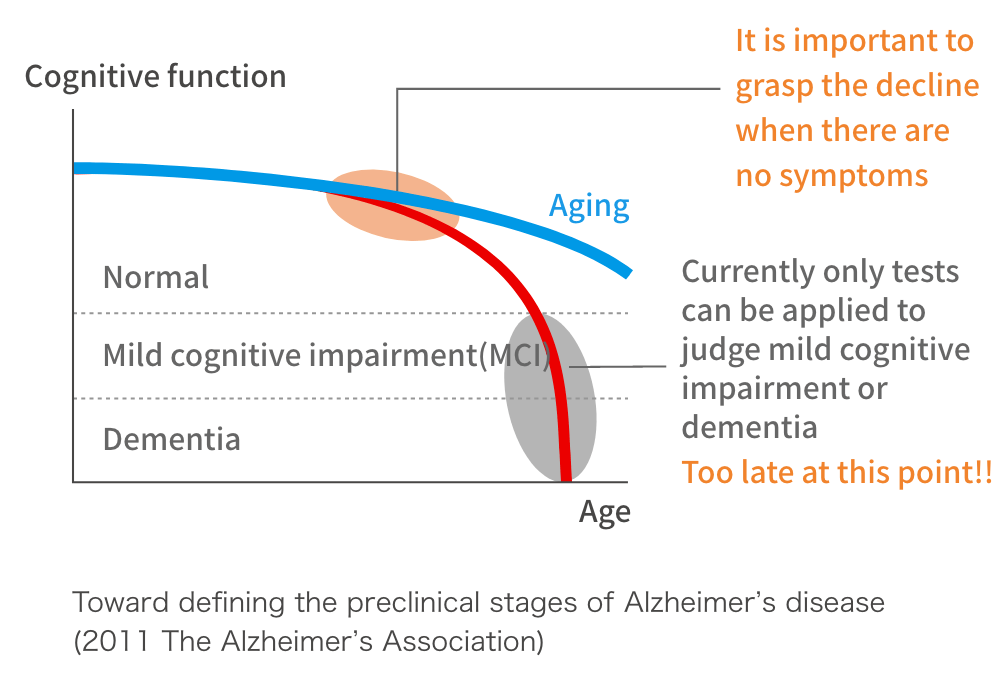

The light blue line indicating "aging" in the figure shows how the cognitive function of the brain declines with age. In other words, it represents that the "age-appropriate forgetfulness" is progressing.
However, the condition should be considered serious when the line drops rapidly like the red curve from the place of the orange circle mark, which indicates the occurrence of dementia or the pre-state of mild cognitive impairment (MCI). As mentioned earlier, the condition will be judged as "normal" in medical institutions. However, the progress has already begun actually.
04“Brain Assessment” is applied to build the awareness for dementia
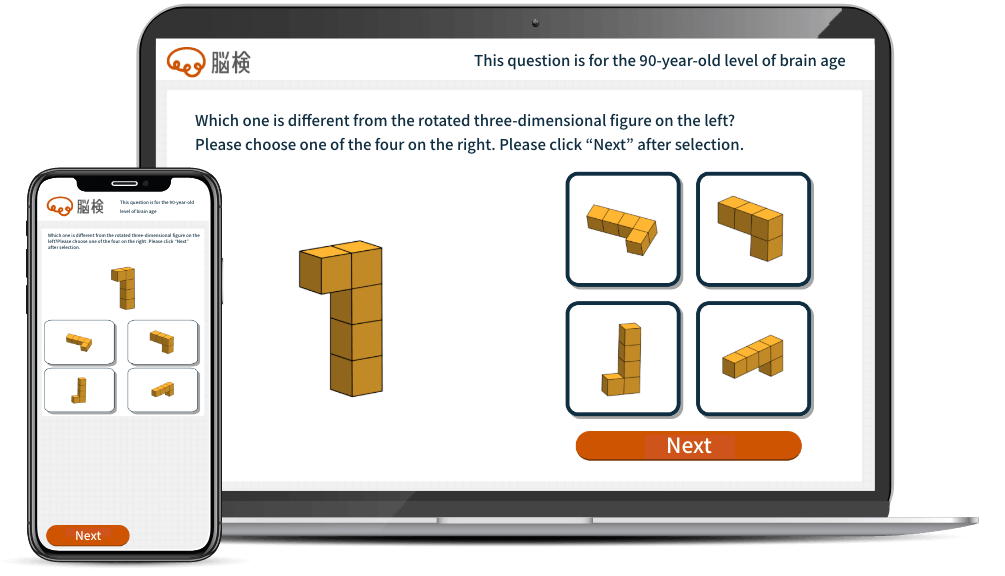

It is essential to know whether your cognitive function is declining. The important thing is to check if the level of your cognitive function has changed compared with your own generation, which works for both for those who are good at learning and those who are not.
It is very important to regularly check whether your cognitive function is normal aging or not, rather than comparing with others.
-
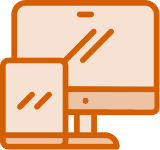
It is a test that checks whether the cognitive function of the brain is age-appropriate.
Recommended age: 25-90 years old
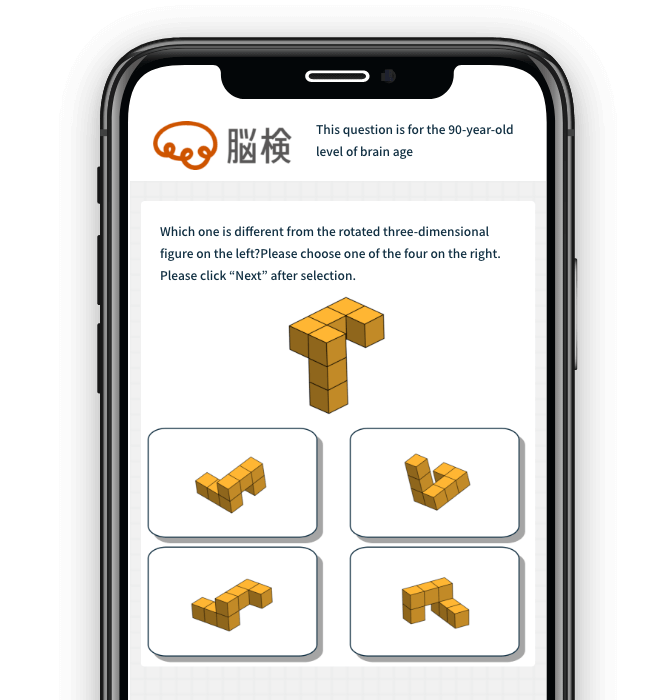
-
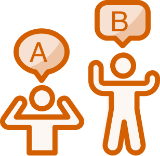
The Brain Assessment
has 5 sub tests,
and 2 minutes per item.
It is an all-multiple-choice testing with simple operation and you can rest assured as there are practice questions at the beginning.Scores will be given depending on how many questions can be answered in 2 minutes and the number of correct answers.Answer as many as you can.
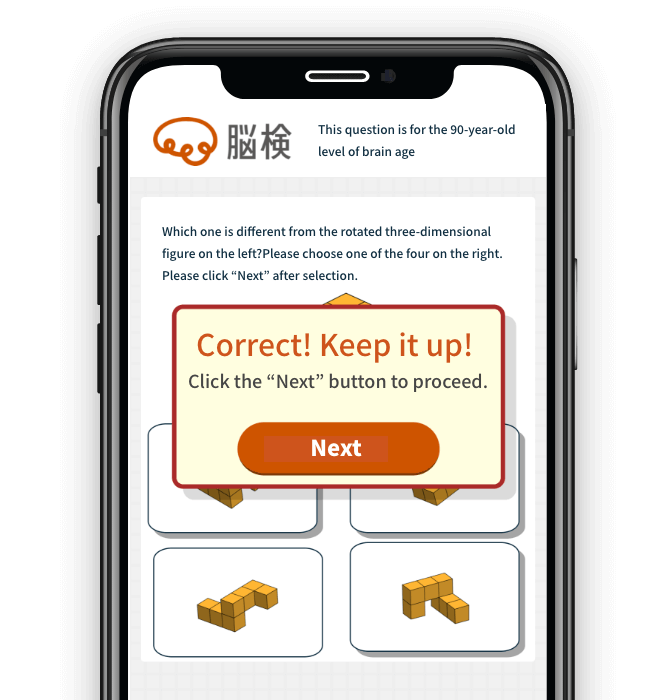
-
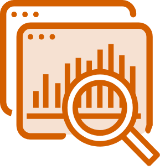
The results will be displayed right away, from which you can know your Brain Age, the deviation value compared with the same generation, the comparison with the past results and the measures taken in the future, etc.
The result is calculated based on the data of 5740 test-takers.
Online Tool (Brain Assessment) for the Detection of Cognitive Function Changes during Aging:Dementia and Geriatric Cognitive Disorders 2021- Online Tool (Brain Assessment) for the Detection of Cognitive Function Changes during Aging
- The Correlation between a New Online Cognitive Test (the Brain Assessment) and Widely Used In-Person Neuropsychological Tests
- Shorter Version of the Brain Assessment Is Suitable for Longitudinal Public Cognitive Evaluations
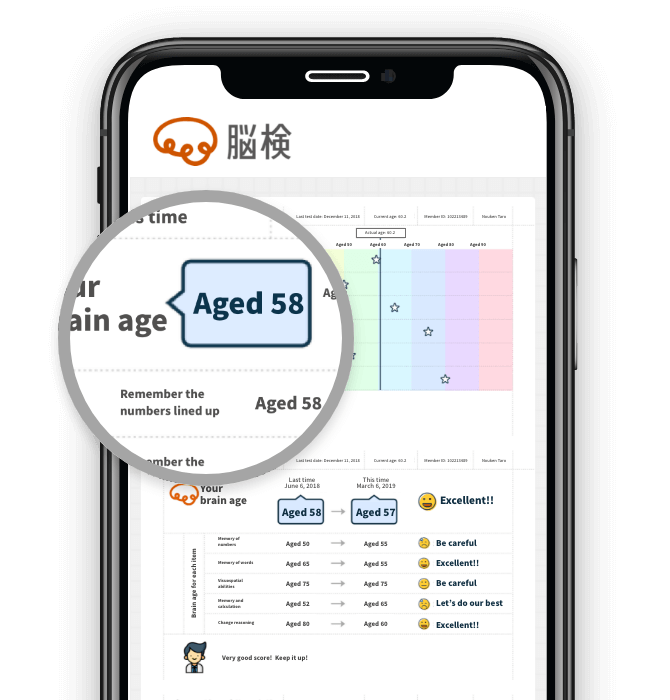
-
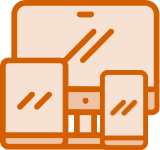
Access from smartphone, tablet and personal computer
Access from home, destination and workplace.
The Brain Assessment can be taken freely anytime and anywhere.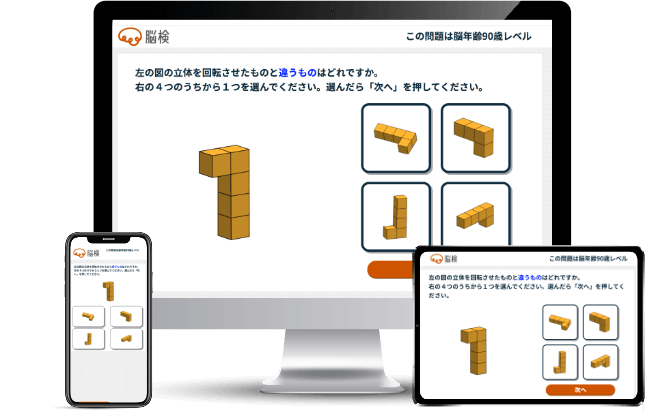
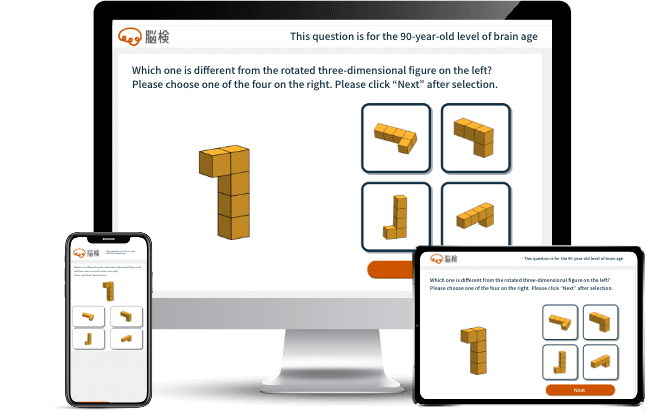
This test is to grasp the current status and changes of cognitive function by comparing with sample data. However, it can not be used as a medical diagnosis of dementia or mild cognitive impairment, nor is it a training tool to prevent their onset.
Introduction of question examples
01Numerical Memory
The questions for testing the memory of numbers are to memorize the numbers in a row and answer the memorized numbers on the next page from left to right or from right to left. The number will be 3 digits at first and increase gradually.
The activation of temporal lobe (side of the head, above the ears) and trends such as Alzheimer's disease can be detected by testing the short-term memory.
02Memory of words
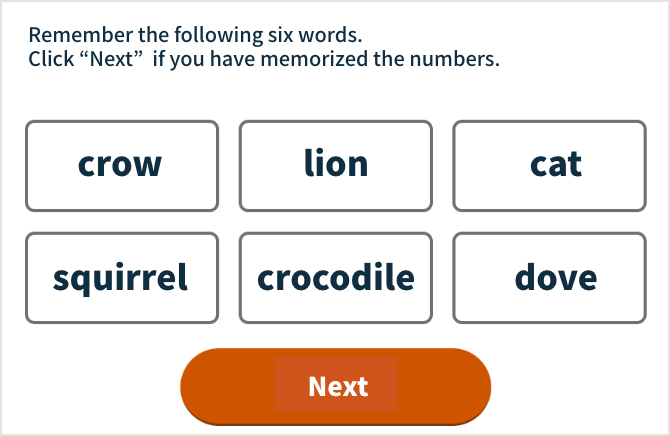
The questions for testing the memory of words are to memorize six words and resolve a few other questions after memorizing the words. The words presented later should be answered whether are among the six words you have memorized. It starts with simple words and the words will become difficult, such as conceptual words.
03Visuospatial abilities
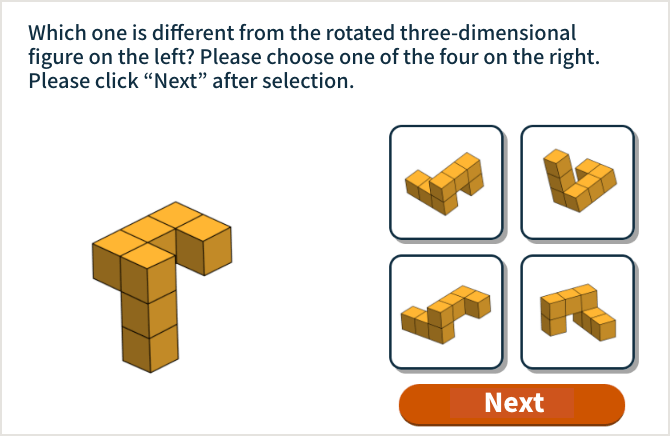
The questions for testing the visuospatial abilities are to select the different one among several rotated three-dimensional objects made of building blocks. It starts with simple shape and the three-dimensional objects will be complicated with the number of blocks increased gradually.
The activation of occipital lobes (top of the head) and trends such as Lewy Bodies can be detected by testing the visuospatial abilities.
04Memory & Computational ReasoningMemory and calculation
Memorize the numbers that appear on the screen and add them to the numbers displayed on the next screen. Repeat the addition of the two numbers before and after. It starts by adding the number one before and will be harder by adding the numbers two or three before.
The activation of frontal lobes (anterior side of the head) and trends such as Pick's disease and vascular dementia can be detected by testing the memory and calculation.
05Diagrammatic Reasoning
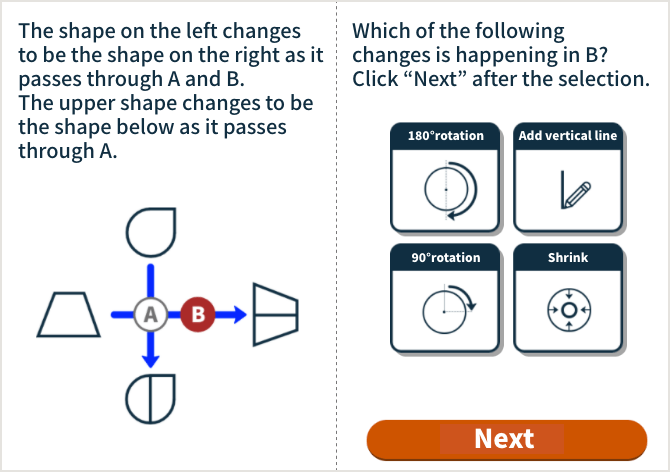
The reasoning for change refers to predict the change of shape which varies according to the rules and test the ability to decipher the rules. It starts with only one change of shape and will be complicated with two or three changes in shape simultaneously.
The activation of frontal lobes (anterior side of the head) and trends such as Pick's disease and vascular dementia can be detected by testing the ability to decipher the rules.
The result of the test will be displayed right awayIntroduction of result displaying screen examples
01Overall brain age
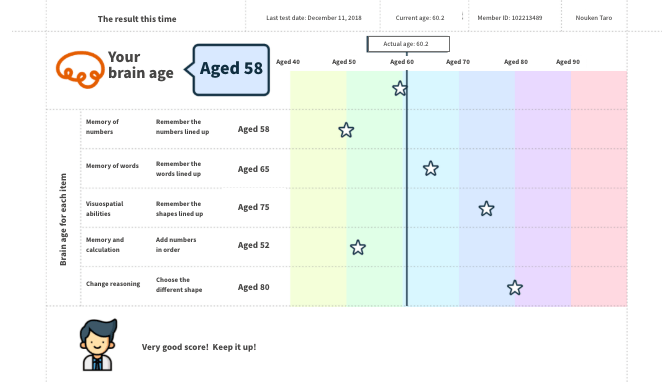
The brain age can be calculated based on the results of each of the five subtests. In addition, the overall brain age can be obtained by taking all 5 subtests.
Different people have subtests that they are good at or not, so please do not concern too much about the result of one subtest and take all the subtests as soon as possible. It is also considered that women have lower level of visuospatial abilities and men are not good at memorizing words.
Brain age is displayed between the ages from 25 to 95. If it is displayed as 25 or 95 years old, please refer to the deviation value.
02The previous results and the future target values
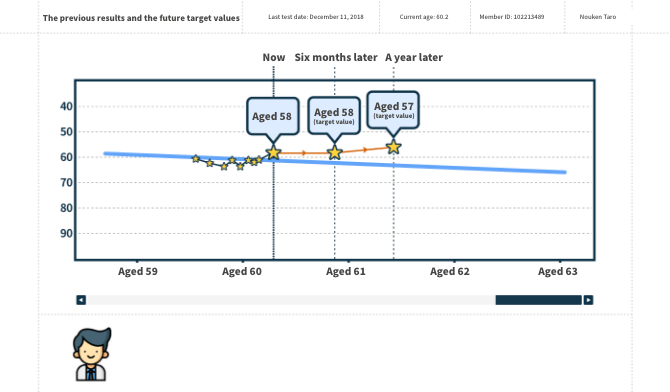
The transition of results so far can be seen in this graph.
The graph also shows the tendency of change in the future. The blue line indicates "average value by age group", it is suggested to aim to reach the value above this line.
In addition, it is generally considered to be “normal aging” if the transition is parallel to the blue line. Measures should be taken if the value is found to be decrease sharply below the blue line.
03Future measures
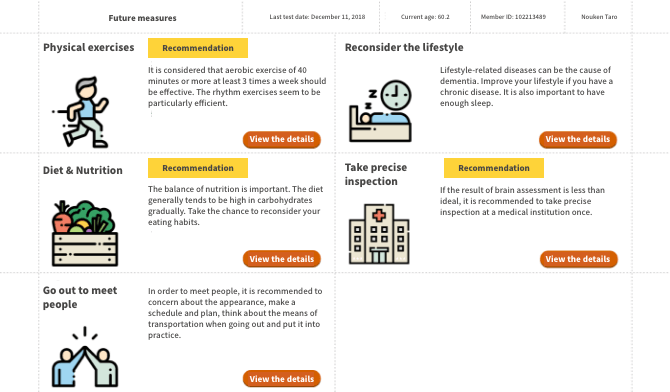
Plenty of information necessary to maintain and improve the level of brain function (cognitive function) are posted.
If you click "View the details" respectively, you will find information on what kind of physical exercises are suitable for you and what kind of meal you should eat.
In addition, the programs of affiliated fitness gyms recommended by brain assessment, outing information and videos of " Research Institute of Brain Activation " (aerobics) are posted for those who cannot go to the gym.
Excerpt from a large number of inquiries receivedFrequently asked questions
-
Is it difficult to operate?
-
All the questions are selection-type items. You can choose the answer just by operating the mouse and touching. In addition, as there are practice questions before the test starts, you can rest assured to take the test after understanding the contents gradually.
-
What should I do if the result is bad?
-
There is no need to worry about cognitive function at current stage if you can "answer properly" to this Brain Assessment. If your brain age is considerably older than your actual age, or if the deviation is significantly lower, please take the test from the practice questions once again. You may take the meaning of the questions in the wrong way. In addition, since only certain subtest may be very low, please take all the 5 items and get the overall brain age.
A little attention should be paid if the overall brain age is 95 and the comprehensive deviation is 30 or less. It is highly likely that you will not be judged as dementia at this stage even if you go to a medical institution, however, it is recommended to have aerobic exercise at least three times a week and strive to maintain and improve cognitive function.
-
What's different from the dementia test?
-
The dementia test and dementia inspection are tests applied by medical institutions to judge "whether or not people have dementia." The oral questions such as " what date is it today" and "Where is this place?" that can be answered by individuals in normal state will be given. The people who can not answer the questions that can be answered easily by anyone should be judged as dementia or mild cognitive impairment. The problem here is the dementia test can be cleared without any problems even though cognitive function is declining. As medical institution is a place to judge an illness and give the treatment, the situation will be judged as "normal" or "wait and see how it goes for a while". However, the cognitive function has been declining. It should be considered that there is a high risk of dementia in the near future if it is left without any treatment.
The Brain Assessment is not a test to judge whether people have dementia, but a test to check if the normal condition is maintained properly. It is not a judgement test used by the medical institution to determine with the standard that “you are sick if you can’t do it”, but is a inspection (test) to check “if the condition is maintained properly comparing with your usual self and your own generation” or “whether your cognitive function has declined even in the situations that you are judged as normal”.
-
What is different from a brain training game or a drill?
-
The latest research indicates that no effect on improving cognitive function in the brain has been made clear with measures taken to train the activities of brain. The Brain Assessment is not a "training" to improve the cognitive function by taking it over and over again, but rather a test to periodically know the state of brain while paying attention to nutritional balance and doing physical exercises.
-
How often should I take the assessment?
-
Since it is important to grasp the decline in cognitive function, it is considered essential to take the test at least once every six months, preferably once every three months and check how it progresses.
Co-developer of Brain Assessment
- Masayuki Satoh, M.D./Ph.D
-
National Center for Geriatrics and Gerontology
Center for Comprehensive Care and Research on Memory Disorders
PC, tablet, smartphoneOperating environment
-
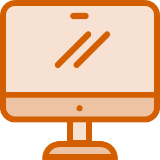
PC and tablet
-
-
Windows
10 or later
(4GB memory or more)- Latest edition of Google Chromes
-
Macintosh
OS X
- Latest edition of Safari
- Latest edition of Google Chrome
※The test can not be operated on the Ipad prior to the 2nd generation.
-
-

Smartphone
-
-
Android
Android 12.0 or later
- Latest edition of Google Chrome
-
iOS
iOS 16.0 or later
- Latest edition of Safari
- Latest edition of Google Chrome
-
Image resolution: 1400px or higher
Depending on the terminal size, etc. Part of the display may collapse.
